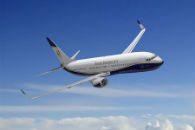Flying by BBJ: From pizza ovens to putting greens

Corporate Jet Investor’s Alex Andrews speaks to Captain Stephen Taylor, president of Boeing Business Jets and experienced pilot, about the company’s luxurious line of private jets.

Boeing’s new BBJ Max in flight.
An airliner converted into a corporate aircraft is perhaps the ultimate aircraft that money can buy. Also known as bizliners, corporate airliners allow their owners – typically heads of states, governments or billionaires – to attend business meetings on opposite sides of the world in the same day, provide infinite options for customisation and offer all the luxury of a penthouse apartment.
Pizza ovens and putting greens
“We see everything,” says Taylor, as he remembers some of the more lavish interiors chosen by his high-flying customers. “Everything from pizza ovens to putting greens. Often, the owner will have a yacht or an apartment decorated in a certain style and they want to reflect that on their aircraft.”
There are 17 aircraft completions centres across the world, which have all been authorised by Boeing. Once a customer has selected which one to use, Boeing delivers a green – or unfinished – jet to the centre, which will then work closely with the customer to decide everything from where to fit the galley to how many bedrooms are required.
Exactly how long a completion will take and how much it will cost depends on the specific demands of the client, but most can expect to wait for between 12 and 18 months – with a few completed as quickly as eight months. A $57m BBJ 1 will usually cost an extra $20m-$25m to complete, a $68m BBJ 2 can stretch to another $25m-$30m and owners of a $74m BBJ 3 can expect to pay a further $35m-$40m.
Since launching the BBJ in 1999, Boeing has also started to provide executive versions of the much larger, longer-ranged 747 and 787 models, which have a list price of $330 million and $200 million respectively. “On a 747, we will often see owners spend just as much – if not more – on the interior as they do on the aircraft,” says Taylor.
All of Boeing’s executive models are capable of carrying well over 20 passengers in high-density configurations, but most owners choose to sacrifice this in favour of more luxurious and spacious configurations – installing multiple bedrooms, bathrooms and a variety of personal touches – to the extent that they are often used to carry just three or four passengers.
Why buy?
A major advantage that the BBJ has over aircraft such as Bombardier’s Global 6000 or Gulfstream’s G650 – which are both capable of a similar range – is that it offers roughly three times more cabin space and far more opportunity for customisation.
“Globals and Gulfstream are very nice, but they look very much the same inside,” says Taylor. “One of our clients used to own a Global Express. He says whenever he gets back into one, he feels like he is getting into a Volkswagen.”
“You buy a BBJ because you want to sleep in a Queen-sized bed and be able to eat a meal that is not served on a fold-out table,” he adds.
As much as Boeing would like to advertise their aircraft as tools for increasing business efficiency, BBJs are also bought – particularly in emerging markets – to represent the status of the owner and to show, as Taylor puts it, that they are at “the very top of the pyramid.”
“China is still coming into the market and it is more about status,” he says. “In America and Europe, that does not happen so much.”
Who buys?
Boeing was the first aircraft manufacturer to enter the converted airliner market in the late 1990s and demand has been strong in the Middle-East and North America, which make up for almost 60 per cent of total orders. Europe and the Asia Pacific region are both responsible for roughly a fifth of all BBJ orders.
“China is a big priority and I think it will remain a focus for some time,” says Taylor. “Chinese customers often need to travel greater distances.”
Although the BBJ is often associated with heads-of-state, with 40 per cent of orders coming from governments, private individuals actually account for almost half of all BBJ orders, whilst charter accounts for 9 per cent and corporate customers make up 4 per cent of BBJ orders.
Something which Boeing is currently concentrating on is the launch of the BBJ Max 8 (pictured above), which will provide same amount of cabin space as the BBJ 2, but with 14 per cent more range and 13 per cent more fuel efficiency.
“Initially, the clients will be the ones that own BBJs today,” says Taylor. I think if I am honest, the 737 that we sell today is pretty much the same aircraft as the one we were selling 16 years ago. The Max will be big. It will allow owners living on the West Coast of America to fly to Eastern Europe easily.”








